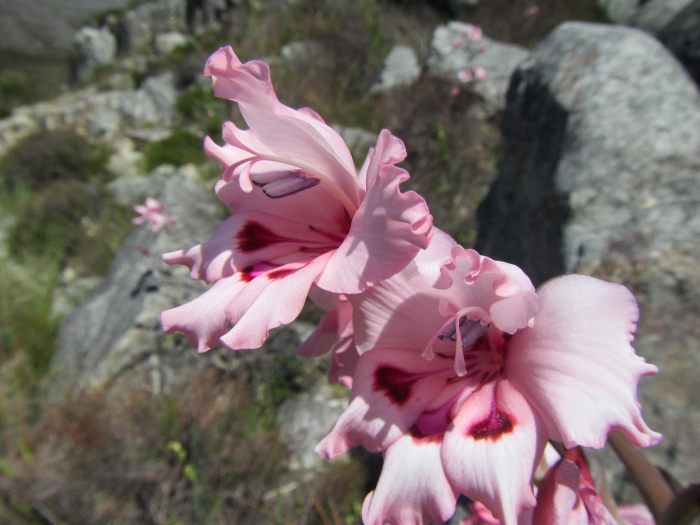Painted Lady Gladiolus
(Gladiolus carneus)
Painted Lady Gladiolus (Gladiolus carneus)
/
/

douglaseustonbrown
CC BY-SA 4.0
Image By:
douglaseustonbrown
Recorded By:
Copyright:
CC BY-SA 4.0
Copyright Notice:
Photo by: douglaseustonbrown | License Type: CC BY-SA 4.0 | License URL: http://creativecommons.org/licenses/by-sa/4.0/ | Rights Holder: douglaseustonbrown | Publisher: iNaturalist | Date Created: 2019-10-05T12:32:11-07:00 |

























Estimated Native Range
Summary
Gladiolus carneus, commonly known as Painted Lady Gladiolus, is a perennial herb that is native to the winter rainfall regions of the Western Cape and Eastern Cape provinces in South Africa, where it is found in sandy soils in fynbos and renosterveld vegetation. It typically grows to about 20 inches (50 cm) in height and is summer dormant, aligning its growth cycle with the winter rainfall pattern of its native habitat. The Painted Lady Gladiolus produces spikes of funnel-shaped flowers that are pink with streaks of darker pink or red, blooming in the spring. The flowers are quite showy and are excellent for cutting, adding a splash of color to floral arrangements.
This species is valued for its striking flowers and adaptability to Mediterranean climates, making it a popular choice for ornamental gardens. In cultivation, it requires well-drained soil and full sun to part shade. It is drought-tolerant once established and should be kept dry during its summer dormancy. Planting corms in autumn will allow them to establish with the seasonal rains. While it is relatively low-maintenance, it can be susceptible to thrips and fungal diseases such as rust if conditions are too moist. In regions with wet summers, it is often grown in pots, which allows for better control of watering and the ability to store the corms dry during their dormant period.CC BY-SA 4.0
This species is valued for its striking flowers and adaptability to Mediterranean climates, making it a popular choice for ornamental gardens. In cultivation, it requires well-drained soil and full sun to part shade. It is drought-tolerant once established and should be kept dry during its summer dormancy. Planting corms in autumn will allow them to establish with the seasonal rains. While it is relatively low-maintenance, it can be susceptible to thrips and fungal diseases such as rust if conditions are too moist. In regions with wet summers, it is often grown in pots, which allows for better control of watering and the ability to store the corms dry during their dormant period.CC BY-SA 4.0
Plant Description
- Plant Type: Bulb, Herb
- Height: 0.6-2 feet
- Width: 0.25-0.3 feet
- Growth Rate: Moderate
- Flower Color: Pink, Red
- Flowering Season: Spring
- Leaf Retention: Deciduous
Growth Requirements
- Sun: Full Sun
- Water: Low, Medium
- Drainage: Fast, Medium
Common Uses
Border Plant, Low Maintenance, Potted Plant
Natural Habitat
Native to winter rainfall regions of the Western Cape and Eastern Cape provinces in South Africa, found in sandy soils in fynbos and renosterveld vegetation
Other Names
Common Names: Painted Lady, Evening Flower, White Afrikaner, Marsh Afrikaner
Scientific Names: , Gladiolus carneus, Gladiolus albidus, Gladiolus blandus, Gladiolus blandus var. carneus, Gladiolus blandus var. excelsus, Gladiolus blandus var. purpureoalbescens, Gladiolus callistus, Gladiolus callistus var. gracilior, Gladiolus campanulatus
GBIF Accepted Name: